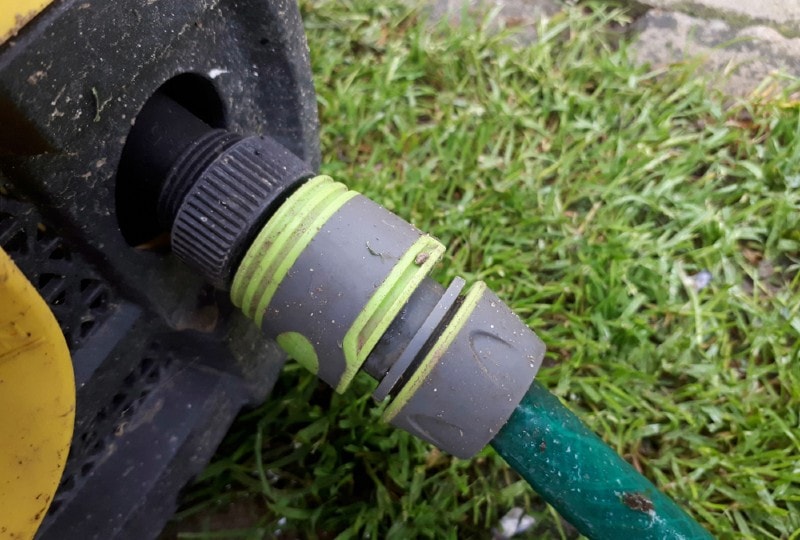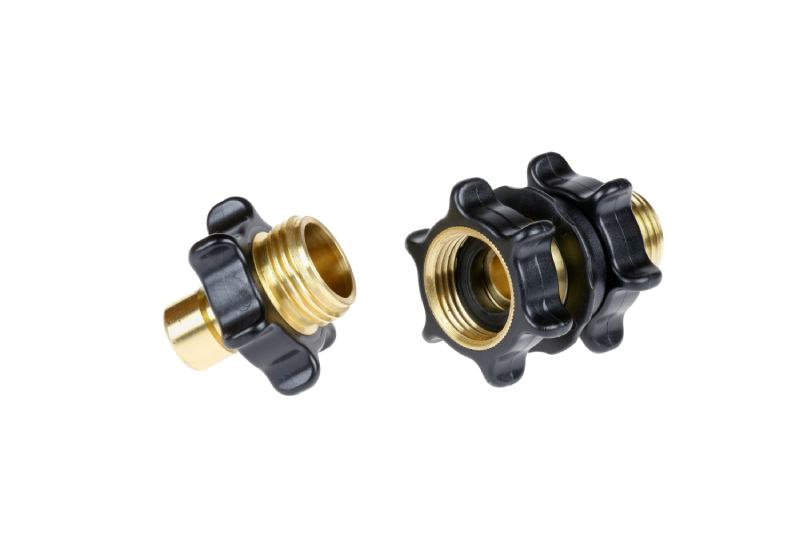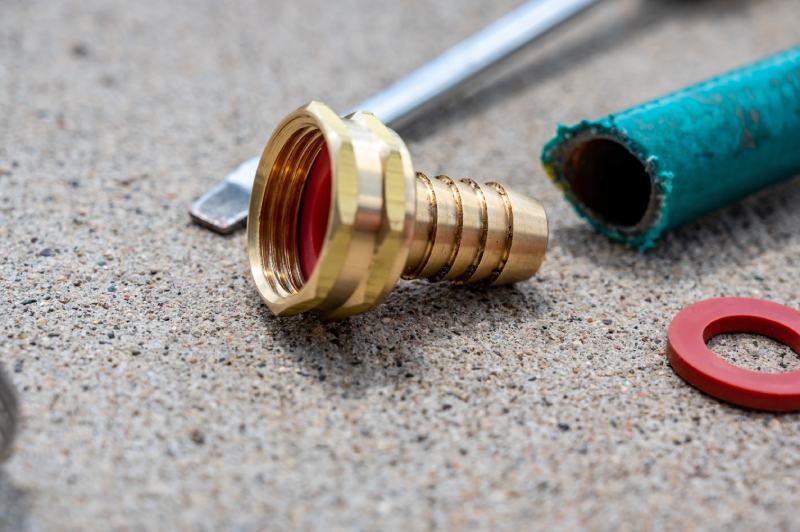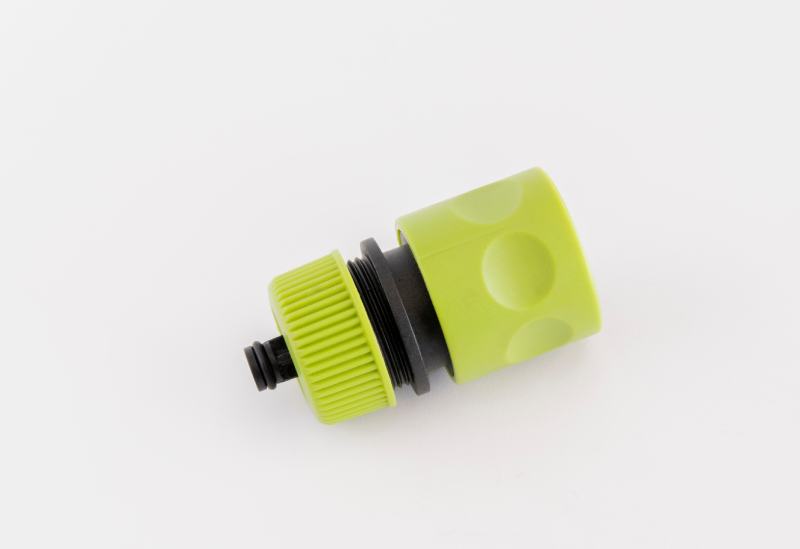9 Pressure Washer Connector Types: Pros and Cons (With Pictures)
-
Pete Ortiz
- Last updated:

Buying a connector that doesn’t fit your particular pressure washer is a common occurrence. People grab connectors off the shelf without realizing that there are multiple sizes and styles of fitting that only work for certain pressure washers. Trying to jam an ill-fitting connector into a bad fitting is frustrating and can cost you time and money. If you’ve ever been frustrated or confused about pressure washer connector types, you are not alone.
There are nine common types of pressure washer fittings and materials that are each different from the other. Mixing and matching the wrong connectors will lead to parts that don’t fit and a pressure washer that won’t run effectively. Here are the common types of pressure washer connectors and materials you can find today.
The 9 Types of Pressure Washer Connectors
Standard Types
1. 14mm M22

Standard M22 fittings, or 14mm M22 fittings, are common connectors used on gas powered pressure washers, as opposed to electric power washers. These fittings are fairly large, measuring just over half an inch in diameter. The fittings are threaded and use a male and female end. M22 fittings are generally made of brass, and they can be screwed tightly into place to form a tight seal for high pressure washing. M22 fittings are usually found on high pressure power washers.
The biggest downside to the M22 connector is the fact that they take time to screw and unscrew. M22 connectors have the potential to become stuck fast due to corroded threading or disuse.
- Commonly found
- Good for high pressure machines
- Can create a very tight seal
- Have to be screwed and unscrewed
- Can become stuck
2. 15mm M22
The 15mm M22, or the electric M22, is an identical fitting to the 14mm M22 connector. The only difference is the fact that the electric pressure washers use a 15mm variety which is 1mm larger than the standard gas powered M22 fitting. The 15mm M22 connector measures roughly 3/5” in diameter. M22 fittings are named for their exterior diameter which is 22mm. The interior diameter can either be 14mm or 15mm, depending on the fitting.
It is common to mistakenly pick up M22 fittings for gas powered pressure washers that will not fit properly on electric pressure washers. The electric M22 connectors have the same potential issue of seizing up and becoming stuck.
- Forms a tight seal
- Works for gas powered pressure washers
- Easily confused with 14mm M22 connectors
- Can get stuck if not maintained properly
3. 3/8″ Threaded
3/8″ threaded connectors look very similar to M22 connectors, and they are designed in the same style. However, 3/8″ threaded connectors are smaller and narrower than M22 fittings. These connectors are not compatible with M22 fittings despite their similar shape and function. They still provide a strong seal due to the threaded body. Some pressure washers use 3/8″ threaded connectors, and some use M22. Pressure washers usually use one or the other but not both.
Be sure to check and see if your unit uses M22 or 3/8″ threaded connectors before making a purchase. The 3/8″ threaded connectors are sometimes called the British Standard Pipe (BSP) connection.
- Strong fitting
- Confusing naming scheme
- Can be mixed up with M22 fittings if you are not careful
4. Quick Connectors

Quick connectors are a modern fitting that takes the best parts of the old M22 fittings and makes them more functional. Quick connectors allow you to easily snap on and snap off different fittings for on-the-fly adjustments. Before quick connectors, you would have to screw and unscrew each individual piece. Quick connectors save a lot of time by allowing special fittings to be easily swapped out without having to unscrew anything. Quick connectors can be compatible with M22 or 3/8″ fitted pressure washers.
Quick connectors are very common today, but some professionals don’t like them because they tend to leak and cause issues over a stronger fitting. Many quick connectors are made of plastic which makes them cheaper and more fragile than brass fittings. However, they are great for regular users and homeowners.
- Allows quick adjustments
- Great for homeowners
- Lots of easily obtainable options available
- Compatible with M22 or 3/8″ machines
- Can leak
- Can crack
- Often made of plastic
Non-Standard Type
1. 1/4″ Threaded

1/4″ threaded connectors are used to connect sprayer guns and lances to a hose or to the pressure washer itself. 1/4″ threaded connectors are usually only found on sprayer guns and not on other parts of a pressure washer. Lances and guns can also use M22 fittings and not just 1/4″ threaded fittings. These threaded connectors are smaller than M22 connectors.
If you need to replace a fitting on a hose, gun, lance, or threaded machine part, you should double-check to see if you are dealing with an M22 or 1/4″ threaded fitting.
Male & Female Ends
Any threaded fitting has a male and female end. In order to get any fitting to work, you have to have both a male end and a female end. Male ends have their threading on the outside, while female ends have the threading on the inside. You insert the male end into the female end to get the connectors to work correctly. The female connection holds the male connector in place.
You can’t use fittings without both a male and female end, so make sure you have both parts.
Connector Materials
1. Plastic

Plastic connectors are the cheapest type of fittings and also the most fragile. Plastic connectors are generally only used for low power or electric pressure washers. High power pressure washers can crack or burst cheap plastic fittings due to the PSI loads. If you can afford to upgrade to brass fittings, it is usually worth the money. However, the plastic will not rust or corrode like metal can. Plastic fittings can work for light work at home or for quick jobs if you are in a pinch.
- Cheap
- Easy to find
- Good for quick replacements
- Can crack or burst on high powered pressure washers
- Easy to damage
2. Brass
Brass fittings are one of the most common types of connectors found on any standard pressure washer. Brass bridges the gap between plastic and stainless-steel connectors. They are more durable and more expensive than plastic but cheaper than stainless steel. Brass fittings are great all around. They can be found in a variety of shapes and sizes. They are corrosion resistant and can withstand high pressure and bad weather.
The downside of brass connectors is that they are susceptible to chemicals and salt water. That means that they will corrode faster if you like to use a lot of chemicals or additives in your pressure washer.
- Upgrade from plastic
- Can withstand high pressure
- Corrosion resistant
- Still common and affordable
- Susceptible to chemicals and salt
3. Stainless Steel
Stainless steel fittings are the highest-end material that can be used for pressure washer connectors. Stainless steel fittings are generally used by professionals who use their machines a lot and use a lot of chemicals like cleaners, bleach, or algae killers. Stainless steel will not rust, it can withstand chemical and salt exposure, and it is very strong.
The biggest downside to stainless steel is the price. Stainless steel fittings are the most expensive type of pressure washer connector, but they are also the most durable and long-lasting.
- Corrosion resistant
- Can last years
- Can hold up to chemicals and salt exposure
- Rated for professional use
- Expensive
4. Rubber O-Rings

Rubber O-rings are common components for pressure washing fittings. O-rings prevent leaks and help seal the inside of female connectors. Connectors that do not feature O-rings are more prone to leaking over time. O-rings can be found in quick connectors and M22 fittings. While O-rings are helpful parts of pressure washing connectors, they are prone to cracking, falling out, and crumbling over time. It is hard to replace an O-ring in small fittings.
- Helps prevent leaks
- Present in M22 and quick connect fittings
- Can crack or crumble
- Hard to replace if they fall out
Measuring and Fitting Parts
If you are still determining what type of fitting you have, there are a few things you can do. The easiest thing to do is to bring an example of your fitting to your local hardware store when looking to make a purchase. You can try to match up your existing connectors with the ones at the store to find the perfect fit. The professionals at the store can also usually help you find the correct part if they can look at an existing piece.
The other option is to use digital measuring calipers to measure each fitting to get a precise size. Since many of these fittings differ by just a millimeter or a fraction of an inch, it can be nearly impossible to eyeball the size. Digital calipers will give you an immediate and exact size on all of your fittings, but it requires you to own one, buy one, or borrow one.
Conclusion
There are multiple different types of pressure washer fittings and materials, and each one is slated for a different purpose or machine. In many cases, people do not have a choice on what type of fitting they have to use with their particular pressure washer, but they do have a choice in what material they buy to replace or upgrade their fittings. Knowing the differences between each type of fitting will make replacing or changing your connectors much easier than before.
Featured Image Credit: daily_creativity, Shutterstock
Contents


